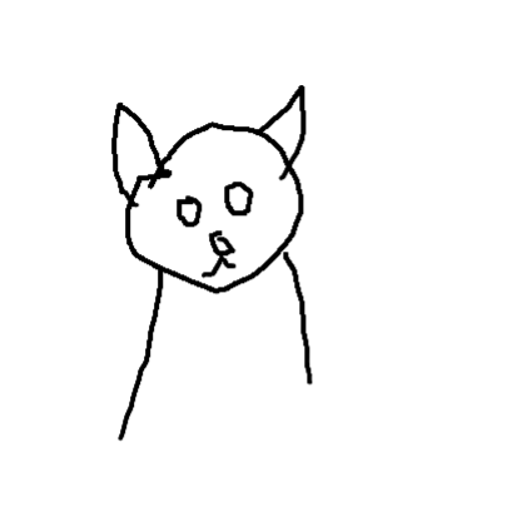One Step Sketch to Image translation with pix2pix-turbo and OpenVINO#
This Jupyter notebook can be launched after a local installation only.
Diffusion models achieve remarkable results in image generation. They are able synthesize high-quality images guided by user instructions. In the same time, majority of diffusion-based image generation approaches are time-consuming due to the iterative denoising process.Pix2Pix-turbo model was proposed in One-Step Image Translation with Text-to-Image Models paper for addressing slowness of diffusion process in image-to-image translation task. It is based on SD-Turbo, a fast generative text-to-image model that can synthesize photorealistic images from a text prompt in a single network evaluation. Using only single inference, pix2pix-turbo achieves comparable by quality results with recent works such as ControlNet for Sketch2Photo and Edge2Image for 50 steps.

In this tutorial you will learn how to turn sketches to images using Pix2Pix-Turbo and OpenVINO.
Table of contents:
Installation Instructions#
This is a self-contained example that relies solely on its own code.
We recommend running the notebook in a virtual environment. You only need a Jupyter server to start. For details, please refer to Installation Guide.
Prerequisites#
Clone model repository and install required packages.
%pip install -qU "openvino>=2024.1.0" "torch>=2.1" torchvision "diffusers==0.25.1" "huggingface-hub<0.26.0" "peft>=0.6.2" transformers tqdm pillow opencv-python "gradio==3.43.1" --extra-index-url https://download.pytorch.org/whl/cpu
import requests
from pathlib import Path
if not Path("cmd_helper.py").exists():
r = requests.get(
url="https://raw.githubusercontent.com/openvinotoolkit/openvino_notebooks/latest/utils/cmd_helper.py",
)
open("cmd_helper.py", "w").write(r.text)
from pathlib import Path
if not Path("notebook_utils.py").exists():
r = requests.get(
url="https://raw.githubusercontent.com/openvinotoolkit/openvino_notebooks/latest/utils/notebook_utils.py",
)
open("notebook_utils.py", "w").write(r.text)
# Read more about telemetry collection at https://github.com/openvinotoolkit/openvino_notebooks?tab=readme-ov-file#-telemetry
from notebook_utils import collect_telemetry
collect_telemetry("sketch-to-image-pix2pix-turbo.ipynb")
from cmd_helper import clone_repo
repo_dir = clone_repo("https://github.com/GaParmar/img2img-turbo.git")
pix2pix_turbo_py_path = repo_dir / "src/pix2pix_turbo.py"
model_py_path = repo_dir / "src/model.py"
orig_pix2pix_turbo_path = pix2pix_turbo_py_path.parent / ("orig_" + pix2pix_turbo_py_path.name)
orig_model_py_path = model_py_path.parent / ("orig_" + model_py_path.name)
if not orig_pix2pix_turbo_path.exists():
pix2pix_turbo_py_path.rename(orig_pix2pix_turbo_path)
with orig_pix2pix_turbo_path.open("r") as f:
data = f.read()
data = data.replace("cuda", "cpu")
with pix2pix_turbo_py_path.open("w") as out_f:
out_f.write(data)
if not orig_model_py_path.exists():
model_py_path.rename(orig_model_py_path)
with orig_model_py_path.open("r") as f:
data = f.read()
data = data.replace("cuda", "cpu")
with model_py_path.open("w") as out_f:
out_f.write(data)
%cd $repo_dir
Load PyTorch model#
Pix2Pix-turbo architecture illustrated on the diagram below. Model
combines three separate modules in the original latent diffusion models
into a single end-to-end network with small trainable weights. This
architecture allows translation the input image x to the output y, while
retaining the input scene structure. Authors use LoRA adapters in each
module, introduce skip connections and Zero-Convolutions between input
and output, and retrain the first layer of the U-Net. Blue boxes on
diagram indicate trainable layers. Semi-transparent layers are frozen.
import copy
from tqdm import tqdm
import torch
from transformers import AutoTokenizer, CLIPTextModel
from diffusers import AutoencoderKL, UNet2DConditionModel
from diffusers.models.autoencoders.vae import DiagonalGaussianDistribution
from diffusers.utils.peft_utils import set_weights_and_activate_adapters
from peft import LoraConfig
import types
from src.model import make_1step_sched
from src.pix2pix_turbo import TwinConv
tokenizer = AutoTokenizer.from_pretrained("stabilityai/sd-turbo", subfolder="tokenizer")
def tokenize_prompt(prompt):
caption_tokens = tokenizer(prompt, max_length=tokenizer.model_max_length, padding="max_length", truncation=True, return_tensors="pt").input_ids
return caption_tokens
def _vae_encoder_fwd(self, sample):
sample = self.conv_in(sample)
l_blocks = []
# down
for down_block in self.down_blocks:
l_blocks.append(sample)
sample = down_block(sample)
# middle
sample = self.mid_block(sample)
sample = self.conv_norm_out(sample)
sample = self.conv_act(sample)
sample = self.conv_out(sample)
current_down_blocks = l_blocks
return sample, current_down_blocks
def _vae_decoder_fwd(self, sample, incoming_skip_acts, latent_embeds=None):
sample = self.conv_in(sample)
upscale_dtype = next(iter(self.up_blocks.parameters())).dtype
# middle
sample = self.mid_block(sample, latent_embeds)
sample = sample.to(upscale_dtype)
if not self.ignore_skip:
skip_convs = [self.skip_conv_1, self.skip_conv_2, self.skip_conv_3, self.skip_conv_4]
# up
for idx, up_block in enumerate(self.up_blocks):
skip_in = skip_convs[idx](incoming_skip_acts[::-1][idx] * self.gamma)
# add skip
sample = sample + skip_in
sample = up_block(sample, latent_embeds)
else:
for idx, up_block in enumerate(self.up_blocks):
sample = up_block(sample, latent_embeds)
# post-process
if latent_embeds is None:
sample = self.conv_norm_out(sample)
else:
sample = self.conv_norm_out(sample, latent_embeds)
sample = self.conv_act(sample)
sample = self.conv_out(sample)
return sample
def vae_encode(self, x: torch.FloatTensor):
"""
Encode a batch of images into latents.
Args:
x (`torch.FloatTensor`): Input batch of images.
Returns:
The latent representations of the encoded images. If `return_dict` is True, a
[`~models.autoencoder_kl.AutoencoderKLOutput`] is returned, otherwise a plain `tuple` is returned.
"""
h, down_blocks = self.encoder(x)
moments = self.quant_conv(h)
posterior = DiagonalGaussianDistribution(moments)
return (posterior, down_blocks)
def vae_decode(self, z: torch.FloatTensor, skip_acts):
decoded = self._decode(z, skip_acts)[0]
return (decoded,)
def vae__decode(self, z: torch.FloatTensor, skip_acts):
z = self.post_quant_conv(z)
dec = self.decoder(z, skip_acts)
return (dec,)
class Pix2PixTurbo(torch.nn.Module):
def __init__(self, pretrained_name=None, pretrained_path=None, ckpt_folder="checkpoints", lora_rank_unet=8, lora_rank_vae=4):
super().__init__()
self.text_encoder = CLIPTextModel.from_pretrained("stabilityai/sd-turbo", subfolder="text_encoder", variant="fp16").cpu()
self.sched = make_1step_sched()
vae = AutoencoderKL.from_pretrained("stabilityai/sd-turbo", subfolder="vae", variant="fp16")
vae.encoder.forward = types.MethodType(_vae_encoder_fwd, vae.encoder)
vae.decoder.forward = types.MethodType(_vae_decoder_fwd, vae.decoder)
vae.encode = types.MethodType(vae_encode, vae)
vae.decode = types.MethodType(vae_decode, vae)
vae._decode = types.MethodType(vae__decode, vae)
# add the skip connection convs
vae.decoder.skip_conv_1 = torch.nn.Conv2d(512, 512, kernel_size=(1, 1), stride=(1, 1), bias=False).cpu()
vae.decoder.skip_conv_2 = torch.nn.Conv2d(256, 512, kernel_size=(1, 1), stride=(1, 1), bias=False).cpu()
vae.decoder.skip_conv_3 = torch.nn.Conv2d(128, 512, kernel_size=(1, 1), stride=(1, 1), bias=False).cpu()
vae.decoder.skip_conv_4 = torch.nn.Conv2d(128, 256, kernel_size=(1, 1), stride=(1, 1), bias=False).cpu()
vae.decoder.ignore_skip = False
unet = UNet2DConditionModel.from_pretrained("stabilityai/sd-turbo", subfolder="unet", variant="fp16")
ckpt_folder = Path(ckpt_folder)
if pretrained_name == "edge_to_image":
url = "https://www.cs.cmu.edu/~img2img-turbo/models/edge_to_image_loras.pkl"
ckpt_folder.mkdir(exist_ok=True)
outf = ckpt_folder / "edge_to_image_loras.pkl"
if not outf:
print(f"Downloading checkpoint to {outf}")
response = requests.get(url, stream=True)
total_size_in_bytes = int(response.headers.get("content-length", 0))
block_size = 1024 # 1 Kibibyte
progress_bar = tqdm(total=total_size_in_bytes, unit="iB", unit_scale=True)
with open(outf, "wb") as file:
for data in response.iter_content(block_size):
progress_bar.update(len(data))
file.write(data)
progress_bar.close()
if total_size_in_bytes != 0 and progress_bar.n != total_size_in_bytes:
print("ERROR, something went wrong")
print(f"Downloaded successfully to {outf}")
p_ckpt = outf
sd = torch.load(p_ckpt, map_location="cpu")
unet_lora_config = LoraConfig(r=sd["rank_unet"], init_lora_weights="gaussian", target_modules=sd["unet_lora_target_modules"])
vae_lora_config = LoraConfig(r=sd["rank_vae"], init_lora_weights="gaussian", target_modules=sd["vae_lora_target_modules"])
vae.add_adapter(vae_lora_config, adapter_name="vae_skip")
_sd_vae = vae.state_dict()
for k in sd["state_dict_vae"]:
_sd_vae[k] = sd["state_dict_vae"][k]
vae.load_state_dict(_sd_vae)
unet.add_adapter(unet_lora_config)
_sd_unet = unet.state_dict()
for k in sd["state_dict_unet"]:
_sd_unet[k] = sd["state_dict_unet"][k]
unet.load_state_dict(_sd_unet)
elif pretrained_name == "sketch_to_image_stochastic":
# download from url
url = "https://www.cs.cmu.edu/~img2img-turbo/models/sketch_to_image_stochastic_lora.pkl"
ckpt_folder.mkdir(exist_ok=True)
outf = ckpt_folder / "sketch_to_image_stochastic_lora.pkl"
if not outf.exists():
print(f"Downloading checkpoint to {outf}")
response = requests.get(url, stream=True)
total_size_in_bytes = int(response.headers.get("content-length", 0))
block_size = 1024 # 1 Kibibyte
progress_bar = tqdm(total=total_size_in_bytes, unit="iB", unit_scale=True)
with open(outf, "wb") as file:
for data in response.iter_content(block_size):
progress_bar.update(len(data))
file.write(data)
progress_bar.close()
if total_size_in_bytes != 0 and progress_bar.n != total_size_in_bytes:
print("ERROR, something went wrong")
print(f"Downloaded successfully to {outf}")
p_ckpt = outf
convin_pretrained = copy.deepcopy(unet.conv_in)
unet.conv_in = TwinConv(convin_pretrained, unet.conv_in)
sd = torch.load(p_ckpt, map_location="cpu")
unet_lora_config = LoraConfig(r=sd["rank_unet"], init_lora_weights="gaussian", target_modules=sd["unet_lora_target_modules"])
vae_lora_config = LoraConfig(r=sd["rank_vae"], init_lora_weights="gaussian", target_modules=sd["vae_lora_target_modules"])
vae.add_adapter(vae_lora_config, adapter_name="vae_skip")
_sd_vae = vae.state_dict()
for k in sd["state_dict_vae"]:
if k not in _sd_vae:
continue
_sd_vae[k] = sd["state_dict_vae"][k]
vae.load_state_dict(_sd_vae)
unet.add_adapter(unet_lora_config)
_sd_unet = unet.state_dict()
for k in sd["state_dict_unet"]:
_sd_unet[k] = sd["state_dict_unet"][k]
unet.load_state_dict(_sd_unet)
elif pretrained_path is not None:
sd = torch.load(pretrained_path, map_location="cpu")
unet_lora_config = LoraConfig(r=sd["rank_unet"], init_lora_weights="gaussian", target_modules=sd["unet_lora_target_modules"])
vae_lora_config = LoraConfig(r=sd["rank_vae"], init_lora_weights="gaussian", target_modules=sd["vae_lora_target_modules"])
vae.add_adapter(vae_lora_config, adapter_name="vae_skip")
_sd_vae = vae.state_dict()
for k in sd["state_dict_vae"]:
_sd_vae[k] = sd["state_dict_vae"][k]
vae.load_state_dict(_sd_vae)
unet.add_adapter(unet_lora_config)
_sd_unet = unet.state_dict()
for k in sd["state_dict_unet"]:
_sd_unet[k] = sd["state_dict_unet"][k]
unet.load_state_dict(_sd_unet)
# unet.enable_xformers_memory_efficient_attention()
unet.to("cpu")
vae.to("cpu")
self.unet, self.vae = unet, vae
self.vae.decoder.gamma = 1
self.timesteps = torch.tensor([999], device="cpu").long()
self.text_encoder.requires_grad_(False)
def set_r(self, r):
self.unet.set_adapters(["default"], weights=[r])
set_weights_and_activate_adapters(self.vae, ["vae_skip"], [r])
self.r = r
self.unet.conv_in.r = r
self.vae.decoder.gamma = r
def forward(self, c_t, prompt_tokens, noise_map):
caption_enc = self.text_encoder(prompt_tokens)[0]
# scale the lora weights based on the r value
sample, current_down_blocks = self.vae.encode(c_t)
encoded_control = sample.sample() * self.vae.config.scaling_factor
# combine the input and noise
unet_input = encoded_control * self.r + noise_map * (1 - self.r)
unet_output = self.unet(
unet_input,
self.timesteps,
encoder_hidden_states=caption_enc,
).sample
x_denoised = self.sched.step(unet_output, self.timesteps, unet_input, return_dict=True).prev_sample
output_image = (self.vae.decode(x_denoised / self.vae.config.scaling_factor, current_down_blocks)[0]).clamp(-1, 1)
return output_image
ov_model_path = Path("model/pix2pix-turbo.xml")
pt_model = None
if not ov_model_path.exists():
pt_model = Pix2PixTurbo("sketch_to_image_stochastic")
pt_model.set_r(0.4)
pt_model.eval()
model.fp16.safetensors: 0%| | 0.00/681M [00:00<?, ?B/s]
/home/ea/work/my_optimum_intel/optimum_env/lib/python3.8/site-packages/huggingface_hub/file_download.py:1132: FutureWarning: resume_download is deprecated and will be removed in version 1.0.0. Downloads always resume when possible. If you want to force a new download, use force_download=True. warnings.warn(
diffusion_pytorch_model.fp16.safetensors: 0%| | 0.00/167M [00:00<?, ?B/s]
diffusion_pytorch_model.fp16.safetensors: 0%| | 0.00/1.73G [00:00<?, ?B/s]
Convert PyTorch model to Openvino Intermediate Representation format#
Starting from OpenVINO 2023.0 release, OpenVINO supports direct PyTorch
models conversion to OpenVINO Intermediate Representation (IR)
format
to take the advantage of advanced OpenVINO optimization tools and
features. You need to provide a model object, input data for model
tracing to OpenVINO Model Conversion
API.
ov.convert_model function convert PyTorch model instance to
ov.Model object that can be used for compilation on device or saved
on disk using ov.save_model in compressed to FP16 format.
import gc
import openvino as ov
if not ov_model_path.exists():
example_input = [torch.ones((1, 3, 512, 512)), torch.ones([1, 77], dtype=torch.int64), torch.ones([1, 4, 64, 64])]
with torch.no_grad():
ov_model = ov.convert_model(pt_model, example_input=example_input, input=[[1, 3, 512, 512], [1, 77], [1, 4, 64, 64]])
ov.save_model(ov_model, ov_model_path)
del ov_model
torch._C._jit_clear_class_registry()
torch.jit._recursive.concrete_type_store = torch.jit._recursive.ConcreteTypeStore()
torch.jit._state._clear_class_state()
del pt_model
gc.collect();
# uncomment these lines if you want cleenup download pytorch model checkpoints
# import shutil
# checkpoints_dir = Path("checkpoints")
# for file in checkpoints_dir.glob("*"):
# shutil.rmtree(file, ignore_errors=True)
Select inference device#
from notebook_utils import device_widget
device = device_widget()
device
Dropdown(description='Device:', index=3, options=('CPU', 'GPU.0', 'GPU.1', 'AUTO'), value='AUTO')
Compile model#
import openvino as ov
core = ov.Core()
compiled_model = core.compile_model(ov_model_path, device.value)
Run model inference#
Now, let’s try model in action and turn simple cat sketch into professional artwork.
from diffusers.utils import load_image
sketch_image_path = Path("sketch.png")
if not sketch_image_path.exists():
sketch_image = load_image("https://github.com/openvinotoolkit/openvino_notebooks/assets/29454499/f964a51d-34e8-411a-98f4-5f97a28f56b0")
sketch_image.save(sketch_image_path)
else:
sketch_image = load_image(sketch_image_path)
sketch_image

import torchvision.transforms.functional as F
torch.manual_seed(145)
c_t = torch.unsqueeze(F.to_tensor(sketch_image) > 0.5, 0)
noise = torch.randn((1, 4, 512 // 8, 512 // 8))
prompt_template = "anime artwork {prompt} . anime style, key visual, vibrant, studio anime, highly detailed"
prompt = prompt_template.replace("{prompt}", "fluffy magic cat")
prompt_tokens = tokenize_prompt(prompt)
result = compiled_model([1 - c_t.to(torch.float32), prompt_tokens, noise])[0]
from PIL import Image
import numpy as np
image_tensor = (result[0] * 0.5 + 0.5) * 255
image = np.transpose(image_tensor, (1, 2, 0)).astype(np.uint8)
Image.fromarray(image)

Interactive demo#
In this section, you can try model on own paintings.
Instructions: * Enter a text prompt (e.g. cat) * Start sketching, using pencil and eraser buttons * Change the image style using a style template * Try different seeds to generate different results * Download results using download button
import base64
from io import BytesIO
import gradio as gr
def pil_image_to_data_uri(img, format="PNG"):
buffered = BytesIO()
img.save(buffered, format=format)
img_str = base64.b64encode(buffered.getvalue()).decode()
return f"data:image/{format.lower()};base64,{img_str}"
def run(image, prompt, prompt_template, style_name, seed):
print(f"prompt: {prompt}")
print("sketch updated")
if image is None:
ones = Image.new("L", (512, 512), 255)
temp_uri = pil_image_to_data_uri(ones)
return ones, gr.update(link=temp_uri), gr.update(link=temp_uri)
prompt = prompt_template.replace("{prompt}", prompt)
image = image.convert("RGB")
image_t = F.to_tensor(image) > 0.5
print(f"seed={seed}")
caption_tokens = tokenizer(prompt, max_length=tokenizer.model_max_length, padding="max_length", truncation=True, return_tensors="pt").input_ids.cpu()
with torch.no_grad():
c_t = image_t.unsqueeze(0)
torch.manual_seed(seed)
B, C, H, W = c_t.shape
noise = torch.randn((1, 4, H // 8, W // 8))
output_image = torch.from_numpy(compiled_model([c_t.to(torch.float32), caption_tokens, noise])[0])
output_pil = F.to_pil_image(output_image[0].cpu() * 0.5 + 0.5)
input_sketch_uri = pil_image_to_data_uri(Image.fromarray(255 - np.array(image)))
output_image_uri = pil_image_to_data_uri(output_pil)
return (
output_pil,
gr.update(link=input_sketch_uri),
gr.update(link=output_image_uri),
)
# Go back to the sketch-to-image-pix2pix-turbo notebook directory
%cd ..
if not Path("gradio_helper.py").exists():
r = requests.get(url="https://raw.githubusercontent.com/openvinotoolkit/openvino_notebooks/latest/notebooks/sketch-to-image-pix2pix-turbo/gradio_helper.py")
open("gradio_helper.py", "w").write(r.text)
from gradio_helper import make_demo
demo = make_demo(fn=run)
try:
demo.queue().launch(debug=True)
except Exception:
demo.queue().launch(debug=True, share=True)
# If you are launching remotely, specify server_name and server_port
# EXAMPLE: `demo.launch(server_name='your server name', server_port='server port in int')`
# To learn more please refer to the Gradio docs: https://gradio.app/docs/